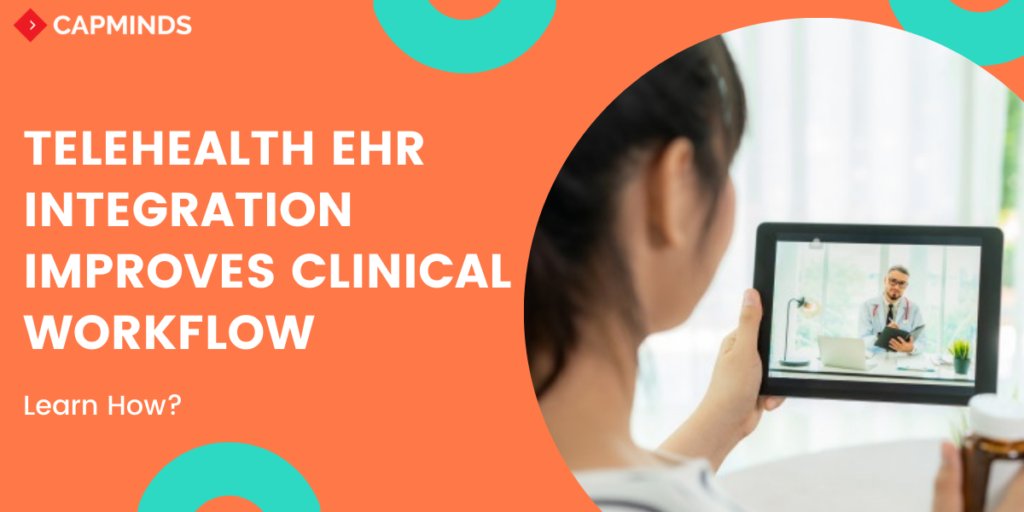Telehealth EHR Integration Improves Clinical Workflow
In today’s healthcare marketplace, around 95% of U.S. hospitals started using the EHR platform, and the benefits of implementing this platform are crystal clear. The EHR software provides better quality of care, more accurate patient information, increased efficiency, and interoperability. Telehealth EHR integration can further benefit healthcare organizations to improve clinical workflow.
Today most of the telehealth providers already integrated their system with the leading EHR software, which allows patient health data to pass easily from one interface to another. So EHR and telehealth, when used together, can significantly improve the care delivery system. In this article, we discuss the benefits of Telehealth EHR integration and how it improves clinical workflow.
Benefits Of Telehealth EHR Integration
1. EHR Telehealth Integration Automates Data Entry
Data entry is a complex process when it is done in telehealth and EHR software separately. After consulting with a patient remotely, the healthcare provider needs to create a summary of the telehealth visit. So here if the telehealth software isn’t integrated with the facility’s EHR system, they will also need to enter that same information into the patient’s health records again, taking huge time and administrative work.
But with EHR and telehealth integration, the providers no need to enter the same information twice which reduces duplicate data entries, administrative tasks and increases efficiency in the workplace. Here when the healthcare provider takes notes during a telehealth visit, the patient’s health information is automatically updated into the patient’s health record, totally simplifying the data entry process. This also reduces data error when updating the EHR system, ensuring healthcare providers have access to updated patient health information.
RELATED: 11 BENEFITS OF TELEHEALTH IN HEALTHCARE 2022
2. Integrated EHR & Telehealth Synchronizes Patient Insurance Information
As the use of telehealth software has expanded rapidly throughout the 2020 world pandemic, not only patients and physicians are making use of it, the payers also started concentrating on the telehealth technology. As more insurance companies begin to cover telehealth services, monitoring telehealth coverage can be a challenge if a provider doesn’t have access to patients’ insurance information at the time of the visit.
However, when healthcare providers integrate their telehealth and EHR systems, they can easily verify patient eligibility before signing them up for a virtual consultation. This ensures providers are reimbursed for their time and services, reducing confusion and costly delays in the workplace. Many EHR developers link their systems to insurance databases, making it simpler for providers to track patient eligibility quickly.
RELATED: TELEHEALTH – THE FUTURE OF HEALTHCARE
3. Telehealth EHR Integration Offers Real-time Health Information Access
When the telehealth platform is not integrated with EHR, it is not possible to simultaneously view patient health records, scheduling, lab results and more while visiting with patients. With telehealth EHR integration, managing virtual visits is much easier when embedded within their Electronic Health Record. Providers can easily view PHI on the same screen as their patient visit to offer the best clinical experience possible.
4. Integrated EHR and Telehealth Offers Positive Patient Experience
An EHR integrated telehealth platform improves the patient experience. The all in one solution makes your patient impressive, as they no need to log in with separate platforms that are not related to your practice. This improves your patient trust as the integrated platform is safe and secure to use, improving the overall patient experience with simple access to their visit.
5. Telehealth EHR integration Provides Simplified Virtual Care Experience
When a physician consults with a patient during a telehealth visit, they need access to the patient’s health records to properly treat the patients for their symptoms and provide proper consultation. Integrating telehealth and EHR system allows providers to easily access the patient’s medical records, utilizing the same system they are already familiar with. Launching audio/video consultations directly from existing EHR systems creates simplified virtual care workflows as same as the face-to-face provider/patient interactions.
RELATED: CAN TELEHEALTH FLATTEN THE COVID-19 CURVE
Final Thoughts
In future the telehealth platform is going to be more engaging and make life easier for both the patients and the healthcare providers. So merging these EHR and telehealth systems eases the flow of health data, reduces the chances of data input errors when updating patient records, simplifies the billing process and improves patient outcomes.
Looking for the telehealth platform that integrates with your current EHR system?



![The Guide to Custom EHR Application Development [Features + Benefits]](https://www.capminds.com/wp-content/uploads/2024/11/Blog-Featured-Images-2024-11-25T110915.039-400x250.jpg)
